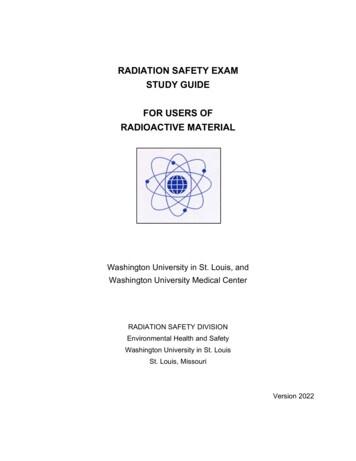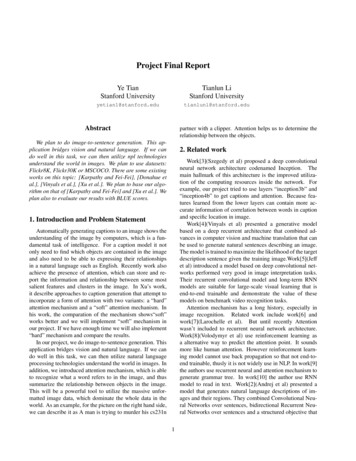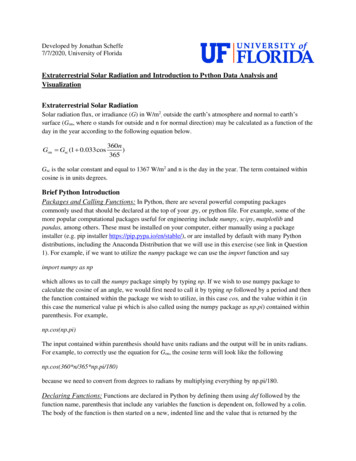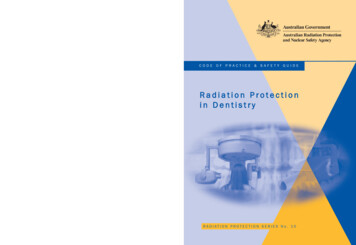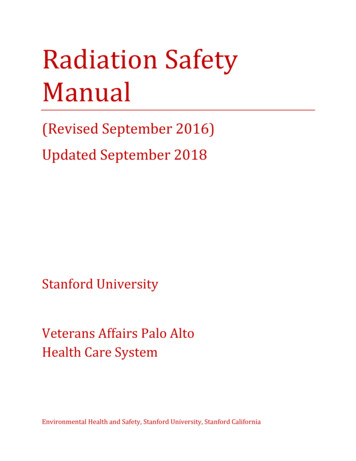
Transcription
Radiation SafetyManual(Revised September 2016)Updated September 2018Stanford UniversityVeterans Affairs Palo AltoHealth Care SystemEnvironmental Health and Safety, Stanford University, Stanford California
Radiation Safety Manual(Revised September 2016)Updated September 2018Stanford UniversityVeterans AffairsPalo Alto Health Care SystemEnvironmental Health and Safety, Stanford University, Stanford California
CREDITSThis Radiation Safety Manual was developed by the Health Physics staff of StanfordUniversity. The Radiation Safety Manual is published and copyrighted by StanfordUniversity.For more information and updates on health and safety, visit the EH&S website:http://www.stanford.edu/dept/EHS/prod/
Radiation Safety ManualPREFACETABLE OF CONTENTSIPART 1 THE SCIENCE AND TECHNOLOGY OF IONIZING RADIATION1Sources of ionizing radiationRadioactivityProperties of radioactivity and units of measureElectronic sources of ionizing radiationInteractions of particulate radiation with matterInteractions of photons with matterMeasurement of radiation and a unit of exposureBiological effects of radiation and units of doseALARA policyGeneral workplace safety guidanceReferences for additional informationPART 2 REGULATIONS FOR THE SAFE USE OF IONIZING RADIATION10 CFR Part 19--Notices, Instructions, and Reports to Workers; Inspections10 CFR Part 20--Standards for Protection Against Radiation10 CFR Part 35--Medical Use of Byproduct MaterialTitle 17--California Code of RegulationsResponsibilitiesWords of cautionPART 3 ADMINISTRATIVE AND TECHNICAL PROCEDURESGeneralControlled Radiation Authorizations (CRAs) for radioactive materialsReview and approval of applications; amendmentsHuman use clinical procedures and researchControlled Machine Authorizations (CMAs) for radiation devicesSetting up the radioactive materials laboratorySetting up the radiation device laboratorySigns and labelsPersonnel monitoringOrdering and receiving radioactive materialUse and transfer recordsSurveysRadioactive WasteRADIATION SAFETY MANUAL (REVISED JANUARY 24445474749495153
Problems Related to Radioactive Wastes58Response to spills, losses, and other incidents59PART 4 APPENDICESGlossarySafety data sheets for commonly-used radionuclidesSafety Data SheetReports applicable to the institutional use of radiation10 CFR Part 20 Appendix C- Quantities of licensed material requiring labelingConversion TablesSigns and LabelsFormsIndex636470718082929396107LIST OF FIGURESFigure 1.1 Typical beta-spectraFigure 1.2 Maximum range of beta particlesFigure 1.3 Typical gamma-ray spectrumFigure 1.4 X-raysFigure 1.5 The photoelectric effectFigure 1.6 Compton scatterFigure 1.7 A simple gas detectorFigure 1.8 The characteristic curve for gas detectorsFigure 1.9 Half value layer for photon energies from 10 keV to 100 MeVFigure 1.10 Typical film badgeFigure 1.11 Sources of radiation dose in the United StatesFigure 2.1 Radiation symbol567111313151515172130LIST OF TABLESTable 1.1 Maximum energy and half-life of selected beta-emittersTable 1.2 Γ- factor, half-life, photopeak, and half value layer for selected gammaemittersTable 1.3 Standard work rules for radiochemical laboratoriesTable 2.1 Dose limits for adult workers, minor workers, and members of the publicTable 2.2 Posting RequirementsTable 3.1 QLM quantitiesTable 3.2 Controlled Radiation Authorization (CRA) quantities and termsTable 3.3 Action levels for removable contaminationTable 3.4 Approximate detection efficiencies for some common radionuclides and detector sRADIATION SAFETY MANUAL (REVISED JANUARY 2017)II5826303135395253
THE SCIENCE AND TECHNOLOGY OF IONIZING RADIATIONPart 1 THE SCIENCE AND TECHNOLOGY OF IONIZINGRADIATIONThe discovery of x-rays in 1895, and radioactivity in 1896, provided two fundamental foundation stonesfor the revolution in physical science that occurred in the twentieth century. However, the field ofradiation science is sufficiently specialized that it may only be mentioned in passing at theundergraduate level.This part is a primer on the origins of ionizing radiation, its interaction with matter, its measurement, itspotential for adverse health effects, and the measures used to ensure a safe workplace. There are alsomany unique characteristics related to radioactivity and ionizing radiation; those that are important toradiation safety, specifically time, distance, shielding, and cleanliness in the radiochemistry lab, will beexamined. For additional information, consult the references listed at the end of this part.There are many terms of art specific to ionizing radiation and our administrative structure to ensure itssafe use. These terms are defined in the Glossary in Part 4.SOURCES OF IONIZING RADIATIONWe are constantly exposed to ionizing radiation in both the natural and the modern technologicalenvironment. This section describes the sources of ionizing radiation used in the research and teachingenvironment.RadiochemicalsThe evolution of medical research and patient care over the last fifty years wasmade possible in large part by the use of radioactive atoms to label molecules.This technology provides a simple method by which a chemical compound canbe marked, observed, and measured as it is processed by a simple cell cultureor a human being. There are applications throughout the life, physical, andengineering sciences.The quantity of a naturally occurring analyte can be measured with isotopedilution analysis. Similar technologies permit the study of, for example,solubility constants of slightly soluble salts. Environmental samples can beanalyzed using radiometric titration or by measuring naturally occurringradiotracers.Sealed SourcesMany devices use sealed radioactive sources because they provide aconvenient, inexpensive source of ionizing radiation. Sealed radioactivesources are often made by encapsulating the salt or metal of a radionuclide in awelded metal container whose size typically ranges from smaller than a pencilRADIATION SAFETY MANUAL (REVISED JANUARY 2017)1
THE SCIENCE AND TECHNOLOGY OF IONIZING RADIATIONlead to the size of a golf ball. The encapsulation ensures that there will be noradioactive contamination of the laboratory. Alpha “sealed” sources have anopen window construction with the source material bonded to the surface of asilver foil mounted in the recess of the plastic disc. Sealed source applicationsrange from low activity alpha sources that are used in home smoke detectorsthrough high activity, self-shielded irradiators that permit the study of doseeffects.X-ray MachinesAny electronic device that has fast-moving electrons is a potential source ofionizing radiation. One is the diagnostic x-ray machine. First used in 1896, itpermitted non-invasive imaging of internal human structures. Today, in the USalone, diagnostic radiology accounts for two-thirds of our dose from man-madesources.X-ray Diffractionand X-rayFluorescenceBecause their wavelength is comparable to the lattice separation in crystals, xray diffraction units can be used to study the arrangement of atoms in crystals.X-ray fluorescence permits the chemical analysis of a sample because eachelement has a unique fluorescent spectrum whose intensity is proportional tothat element’s concentration in the sample. Both techniques require narrow,intense x-ray beams.High energy X-raymachines andparticleacceleratorsHigh energy x-ray machines, operating in the 4 MV to 25 MV energy range, areused to treat many illnesses, and very-high-energy particle accelerators areused by physicists to understand the internal structure of the elementaryparticles.ElectronMicroscopesAlthough they are electronic devices, electron microscopes do not normallypresent a radiation hazard due to their engineering design and operatingparameters. Microscopists who use uranyl acetate (UA) when examiningbiological specimens should observe hazardous chemical precautions. Any labworker that actively handles the bulk vial to prepare stock UA solutions must belicensed under a Controlled Radiation Authorization (CRA) because of the toxicand radiological hazards posed by UA inhalation. This does not include workersusing only the dilute UA solution to prepare samples or slides. Working with thedilute solution itself does not require staff to be on a CRA or to receiveradiological training. Health Physics should be contacted for guidance regardingCRA review and disposal.Cabinet X-raymachinesCabinet x-ray machines are enclosed, self-shielded, interlocked irradiationchambers. The machine can only operate when the chamber door is securelyclosed. The exposure rates at every location on the exterior meets the ratespecified for uncontrolled areas.RADIATION SAFETY MANUAL (REVISED JANUARY 2017)2
THE SCIENCE AND TECHNOLOGY OF IONIZING RADIATIONRADIOACTIVITYRadioactivity is the spontaneous emission of charged particles or photons by an atomic nucleus that is inan unstable configuration. This event is called a nuclear transformation, a decay, or a disintegration.Each decay event involves loss of mass or charge. There are a variety of radioactive decay modes. Oneof the best sources of information on decay modes is the Chart of Nuclides published by the KnollsAtomic Power Laboratory. Decay schemes for selected isotopes also appear in many texts and referencebooks. For a more complete introductory discussion, see Alpen ch. 3, Hendee ch. 3, Turner ch. 3, orBushberg ch. 14.AlphaThe alpha particle is simply a helium nucleus, comprised of two protons and twoneutrons. It is associated with the radioactive decay of elements of high atomicnumber. For example,Ra 222Rn 4 226Each alpha particle has a charge of 2 and a mass of 4. Most have an initialkinetic energy of about 5 MeV. They are frequently accompanied by high energygamma rays. Almost all radionuclides that decay by alpha emission have atomicnumber greater than 83 (bismuth). See Krane ch. 8.Properties of αparticlesBecause of their 2 charge and relatively low velocity, alpha particles are denselyionizing, depositing an enormous amount of energy at each collision with anattenuating atom. Thus, they lose all of their kinetic, ionizing energy aftertravelling a very short distance in any medium. A thin piece of paper, or thelayer of dead cells on your skin surface, will completely attenuate a beam ofalpha particles. Therefore, alpha particles pose no external hazard. However, ifingested, they can deliver a very large radiation dose to tissue. For example,radium is in the same column of the periodic table of elements as calcium, and isa bone seeker. Ingestion of radium can cause a very large radiation dose toblood-forming cells.BetaThe beta particle is an electron that has been ejected from a neutron-richnucleus. It differs from an electron only because it is a product of radioactivedecay. This leads us to observe that the neutron is essentially a proton with anattached electron. During the radioactive decay event, the neutron reverts to aproton, an energetic electron and a neutrino that escapes the nucleus. Forexample,C 14N 0 - MeV 14The maximum kinetic energy of the beta particle, in this example 0.156 MeV, canrange from as low as 0.019 MeV for a 3H decay to as high as 1.7 MeV for a 32PRADIATION SAFETY MANUAL (REVISED JANUARY 2017)3
THE SCIENCE AND TECHNOLOGY OF IONIZING RADIATIONdecay, or 3.3 MeV for a 214Bi decay. The higher energy particles are morepenetrating. See Table 1.1 for other examples of beta emitters.Unlike the discrete energies observed for alpha particles and gamma rays, theaverage kinetic energy of all beta particles from a given isotopic sample is aboutone-third the maximum energy that is possible for that isotope. See Figure 1.1.The maximum and average are characteristic for the isotope. For a low energybeta particle, we might ask where the missing energy has gone. To explain this,Pauli postulated the existence of a new particle, the neutrino ( , emittedsimultaneously and sharing the energy of the decay event with the beta particle.Neutrinos have little mass and no charge, and do not frequently interact withmatter.Properties ofβ- particlesAs with alpha particles, beta particles are completely attenuated by smallthicknesses of common materials. See Figure 1.2. They pose an external sourceof radiation dose to the skin and eyes. A beta emitter can also cause radiationdose if ingested.A low atomic number material such as plastic is used for shielding a beta emitter.The dose rate from a point beta source with energy greater than 0.5 MeV is:X(rad/hr) (2.7 x 105 A ) / r2Where X is the dose rate measured in rad/hr, A is activity in Ci, and r is distancein cm. For example, the beta dose rate at 3 cm from a 1 mCi vial of P-32 is:2.7 x 105 x 0.001 / [3]2 30 rad/hrPositronA few isotopes, such as 11C, 13N, and 18F, decay by positron emission. Apositron, the anti-particle of a beta particle, is emitted by a proton-rich nucleus.It has the same mass as an electron, but carries a positive charge. During thedecay event a proton converts to a neutron and a positive electron, or positron,which is ejected from the nucleus. The range and specific energy loss ofpositrons is about the same as that of negative beta particles, but they aredifferent in that they annihilate with an electron from the absorbing material atthe end of their track, yielding two 0.511 MeV photons. That interactionrepresents a conversion of mass to radiant electromagnetic energy.RADIATION SAFETY MANUAL (REVISED JANUARY 2017)4
THE SCIENCE AND TECHNOLOGY OF IONIZING RADIATIONRadionuclideEmax in MeVHalf-lifeH-30.01912.3 yC-140.1565730 yP-321.71014.3 dP-330.24925.4 dS-350.16787.4 dCl-360.7093E5 yCa-450.257163 dKr-850.68710.8 ySr-90*0.54628.6 yY-90*2.2864.1 h*Sr-90 and Y-90 are a parent-daughter pair, and arein equilibrium in a source.Table 1.1 MAXIMUM ENERGY AND HALF-LIFE OF SELECTED BETAEMITTERS. The average energy of beta-particle is about one-third of themaximum.FIGURE 1.1 TYPICAL BETA-SPECTRA. Beta spectra demonstrate two characteristics: maximum beta particle energy; the averagebeta particle energy (typically about one-third of the maximum).RADIATION SAFETY MANUAL (REVISED JANUARY 2017)5
THE SCIENCE AND TECHNOLOGY OF IONIZING RADIATIONFIGURE 1.2 MAXIMUM RANGE OF BETA-PARTICLES AS A FUNCTION OF ENERGY IN THE VARIOUS MATERIALS INDICATED. FromRadiological Health Handbook, p. 122.RADIATION SAFETY MANUAL (REVISED JANUARY 2017)6
THE SCIENCE AND TECHNOLOGY OF IONIZING RADIATIONBeta-GammaMost beta emitters decay to an excited daughter state that releases excessenergy from the nucleus as a gamma ray. A gamma ray is simply a high energyphoton emitted by a nucleus during its transition from a higher energy excitedstate to a lower energy unexcited state. Gamma rays are always preceded by acharged particle decay, most commonly a beta-event. For example,137Cs 137mBa 0β- (1.176MeV)137mBa 137Ba 0 (0.662MeV).Although the second decay, called an isomeric transition from the metastablestate to the ground state, has a half-life of 2.54 minutes, we seldom chemicallyseparate the 137mBa daughter from the 137Cs parent. Thus, it is notuncommon to colloquially refer to a “.662 MeV cesium-137 gamma ray,”although it in fact emanates from a metastable barium nucleus. See Krane ch.10.FIGURE 1.3 TYPICAL GAMMA RAY SPECTRUM. The spectrum of gamma rays emitted by a givenisotope have distinct, characteristic energy peaks that permit identification of the isotope. This isCs-137 spectrum taken with a NaI (TI) detector.IsomerictransitionIf a metastable daughter is sufficiently long-lived, it can be chemicallyseparated from the parent, thus yielding a pure gamma emitter. The mostimportant example is99Mo 99mTc 0 - MeV 99mTc 99Tc 0 MeV The half-lives of the reactions are 2.7 days and 6.0 hours respectively. Thus it ispossible to chemically separate 99mTc from its parent sample of 99Mo, yielding apure gamma emitter sample with a half-life of 6.0 hours. Tc-99m is theradionuclide of choice for non-invasive nuclear medicine imaging.RADIATION SAFETY MANUAL (REVISED JANUARY 2017)7
THE SCIENCE AND TECHNOLOGY OF IONIZING RADIATIONRadionuclideΓ-FactorI-125HalflifeE (MeV)E %HVLmm Pb2.7560.1 d.0271130.03Co-571.512270.9 d.122860.15Tc-99m0.6126.02 h.140900.3I-1312.838.0 d.364823.0Cs-1373.8230.0 y.662896.5Mo-991.1366 h.140917.7Co-6013.75.3 y1.17, 1.3310013.5Ra-226*0.1211600 y0.18630.9(R*cm2/mCi*hr)TABLE 1.2 Γ-FACTOR, HALF-LIFE, PHOTOPEAK, AND HALF VALUE LAYER (HVL) FOR SELECTED GAMMAEMITTERS. E , the gamma energy is based on the highest percentage abundance; the gamma energy isbased on the highest percentage abundance E %. Ra-226*, HVL mm Pb 7.4 with daughter products.The gamma factor indicates dose rate in R/hr at 1 cm from a 1 mCi point source. Its units are R-cm2/mCihr. It can be used to calculate the dose rate at a distance from a point source of the radionuclide byusing the equation:X (Ao r2Where X is the dose rate; A is activity in mCi; is the gamma factor; and r distance in cm.For example, the dose rate at 10 cm from a 2 mCi source of Co-57 is:X 2 mCi x (1.512 R cm2 /mCi-hr) x (10 cm)-2 0.03024 R/hr.The half value layer, or HVL, is the thickness of shielding material needed to reduce the exposure rateby half.InternalconversionIf an excited, metastable nucleus goes to its ground state by transferring itsenergy to a valence electron that is ejected, the process is called internalconversion. This is observed more frequently in heavy nuclei; gamma decay isthe preferred mode for lighter nuclei.Electron captureSome proton-rich radionuclides decay by electron capture. An orbitingelectron, usually from the K-shell, enters the nucleus and combines with aproton to yield a neutron. Its vacancy is filled by a cascading valence electron,which releases its excess energy as a characteristic x-ray. Alternatively, theexcess energy can cause the ejection of a valence electron, called an Augerelectron.SpontaneousfissionA few very massive nuclei, such as Cf-252, can decay by spontaneous fission.About 97% of Cf-252 atoms decay by alpha emission. The remaining 3% of theneutron-rich nuclei split into two lighter nuclei, with the release of an average3.8 neutrons per fission event.RADIATION SAFETY MANUAL (REVISED JANUARY 2017)8
THE SCIENCE AND TECHNOLOGY OF IONIZING RADIATIONNeutronsSmall neutron sources can be fabricated by mixing an alpha-emitter such as238Pu or 241Am with 9Be, which has a loosely bound neutron. The nuclearreaction is:4 9Be 12C 1nThese sources are commonly used in physics and analytical chemistryexperiments when a low-flux neutron source is needed.PROPERTIES OF RADIOACTIVITY AND UNITS OF MEASURECharacteristicdecay schemeThe modes and characteristic energies that comprise the decay scheme foreach radioisotope are specific. If instrumentation is sufficiently sensitive, it ispossible to identify which isotopes are present in a sample, or alternatively, tomeasure only the radioisotope of interest within a sample containing severalradioisotopes.Half-life (T1/2)Probably the best known property of radioactivity is the half-life T1/2. Afterone-half life has elapsed, the number of radioactive decay events in a sampleper unit time will be observed to have reduced by one-half. The decay rate oractivity At at any time t can be described mathematically:At A0 e-.693 t/T½e-.693 is equal to ½, and the exponent t/ T1/2 describes the number of elapsedhalf-lives. Therefore, t and T1/2 must be expressed in the same unit. Forexample, the half-life of I-131 is 8.0 days. If a vial were labeled "29 mCi at 1pmJune 3," the activity in the vial at 1am June 6 is:29 mCi e-.693 ( 2.5 / 8.0) 23 mCiAlternatively, if n is the number of elapsed half-lives, then:At A0 (1/2)n29 mCi (1/2)0.31 23 mCiHalf-lives range from billionths of a second to billions of years. The half-life ischaracteristic of the radioisotope, and cannot be inferred. The half-life isincluded with the description of the decay scheme.Decay constant (λ)The number of decay events in a sample per unit time, or activity A, isproportional to the number of radioactive parent atoms N in the sample; A N. For example, the decay constant for 99mTc is 0.115/hour. The half-life isRADIATION SAFETY MANUAL (REVISED JANUARY 2017)9
THE SCIENCE AND TECHNOLOGY OF IONIZING RADIATIONrelated to the isotope’s decay constant; .693 / T1/2. Thus, we can also writethe decay equation:At A0 e- tFor example, if a vial contains 100 mCi of Tc-99m at 7 am, the activity at 7 pmis:100 mCi e-0.115/hr x 12 hr 25 mCiWhen using any of these equations, be sure that the same unit of time,whether hours or years, is used to measure both half life T1/2, or decayconstant , and elapsed time t.Measures ofactivity (A)The number of disintegrations, or decay events, or nuclear transformations, ina sample per unit time is its activity A. Two common informal units aredisintegrations per second and disintegrations per minute.Curie (Ci)The US unit of activity is the curie (Ci). One curie is 2.2x1012 disintegrations perminute, or 3.7x1010 disintegrations per second. Common multiples are themillicurie and microcurie.Becquerel (Bq)The SI unit of activity is the becquerel (Bq). One becquerel is 1 disintegrationper second. The common multiple is the megabecquerel. Note that 1 mCi 37 MBq.ELECTRONIC SOURCES OF IONIZING RADIATIONProduction of xraysRadioactivity is not the only source of ionizing radiation. Electrons are emittedby a filament heated with an electric current; the process is called thermionicemission. If the electrons are then accelerated through an electric potential ofseveral kV to several MV, and then stopped instantly in a high atomic numbermetal target anode, some of their kinetic energy can be converted to highenergy photons called bremsstrahlung radiation, from the German term forbraking radiation. This radiation is more commonly known as x-rays.However, most of the kinetic energy is converted to heat.For electrons incident on a thick target, the fraction F of energy converted to xrays is approximately:F 7 x 10-4 Z EkZ is the atomic number of the target, and Ek is the accelerating voltage in MV.Therefore, a 1 MV electron beam accelerated to a tungstenRADIATION SAFETY MANUAL (REVISED JANUARY 2017)10
THE SCIENCE AND TECHNOLOGY OF IONIZING RADIATION(Z 74) target will be about 5% efficient in the production of x-rays.F 7 x 10-4 x 74 x 1 0.052The other 95% of the kinetic energy of the electrons is converted to heat.Because x-ray production is directly proportional to the atomic number of thetarget and the accelerating voltage of the device, reducing both variables candramatically reduce the x-ray output of a device. This explains why electronmicroscopes, cathode ray tubes, and television tubes are not significantsources of x-ray exposure. Although they also have a heated filament and abeam of accelerated electrons, the target is a low Z material, and acceleratingvoltages are typically 20 kV to 50 kV. Because the maximum x-ray energycannot exceed the accelerating voltage, most of the x-rays produced cannotpenetrate the glass envelope used to contain the vacuum.X-ray spectraAn x-ray spectrum is continuous, with energies ranging from near 0 keV to themaximum applied voltage. Intensity spikes at energies that are characteristicof the metal used to make the target are superimposed. See Figure 1.3. Thisprocess forms the basis for radiographic internal imaging in medicine. It is alsoused extensively in crystallography studies.FIGURE 1.4 X-RAYS. (a) x-rays are produced when an electron loses kinetic energy while interacting with a target nucleus. (b) xrays demonstrate a continuous bremsstrahlung spectrum with spikes that are characteristic of the anode target material, in thiscase tungsten. The maximum x-ray energy, when expressed in keV, is equal to the voltage applied between the cathode andanode, in this case 120 kV. The average x-ray energy is about one-third of the maximum.X-ray diffractionand x-rayfluorescenceA special word of caution is appropriate for those who use analytical x-raydevices. Although the beam is narrow, its intensity can be 500 rads per secondat the sample, and 10,000 rads per second at the x-ray tube window. Just afew minutes handling a sample with the beam on could cause ulceration thatcan only be treated by amputation.The dose rate for your unit can be calculated:RADIATION SAFETY MANUAL (REVISED JANUARY 2017)11
THE SCIENCE AND TECHNOLOGY OF IONIZING RADIATIONX (rad/sec) 50 x V (kV) x I (mA) x Ztarget / [r (cm)]2 x 74For example, the dose rate at 2 cm from a copper target operated at 80 kV and100 mA is:50 x 80 x 100 x 29/ (2)2 x 74 39000 rad/secFor a further discussion, see Health Physics. 15(6):481-486, December 1968.NeutronsNeutrons can be created by bombarding targets with high energy photons: 9Be 8Be 1n,or accelerated charged particles, for example deuterons:d 3He 4He 1n2INTERACTIONS OF PARTICULATE RADIATION WITH MATTERAlpha particlesThe alpha particle, comprised of two protons and two neutrons, is verymassive, has high kinetic energy, and a charge of 2. Due to its relatively lowvelocity, it leaves a dense track of ionizations caused by coulumbicinteractions. An alpha particle can penetrate about 3 cm of air, but only a fewmicrons of tissue.Beta particlesThe beta particle is a high speed electron, with a charge of -1, ejected from anucleus. The beta particles from a given isotope have a continuous spectrumof energy that is characterized only by the maximum energy associated withthe isotope. Depending on the maximum energy, beta particles can penetratea few microns to a few centimeters of tissue. They also leave a moderatelydense track of ionizations caused by coulumbic interactions.Like the electronic devices described above, beta particles will produce x-rayswhen absorbed by a target. The fraction of beta energy converted to x-rays isapproximately:F 3.3 x 10-4 Z EmaxZ is the atomic number of the target, and Emax is the maximum beta energy inMeV. This relationship explains why we use low Z materials to shield betasources. There is less bremsstrahlung production.NeutronsDepending on their source, neutrons can range in energy from as high as tensof MeV to 0.015 eV. Because they are uncharged, they interact primarily byphysical collision with absorber nuclei. The collisions are characterized byconservation of momentum and kinetic energy, and are called elastic.RADIATION SAFETY MANUAL (REVISED JANUARY 2017)12
THE SCIENCE AND TECHNOLOGY OF IONIZING RADIATIONINTERACTIONS OF PHOTONS WITH MATTERGamma rays andx-raysGamma rays and x-rays are both forms of electromagnetic radiation. Theydiffer only in their source. A gamma ray emanates from the nucleus of aradioactive atom. An x-ray emanates from outside the nucleus of aradioactive atom, or from an electron as it changes direction when passing anatomic nucleus; this latter type of x-ray is called bremstrahlung. All arecollectively referred to as ionizing photonsPhotoninteractionsBecause it is not charged, a photon does not interact by coulumbic force, butrather only by interaction with an electron. The two most common forms ofinteraction are the photoelectric effect, .5, and Compton scattering, Figure 1.6The probability of these events depends on the absorbing medium and thephoton energy. The photoelectric effect predominates for low energy photons(less than 100 keV). Its probability increases dramatically with Z. TheCompton effect predominates for moderate to high energy photons (morethan 100 keV). See Hendee ch 4. These facts drive our selection of shieldingmaterials.FIGURE 1.5 THE PHOTOELECTRIC EFFECT. The photon iscompletely absorbed. Its energy E liberates an electronbound with energy EB, and provides it with kinetic energy EK.Mathematically, E E - EBFIGURE 1.6 COMPTON SCATTER. An incident photon withenergy E liberates an orbiting electron, yielding a recoilelectron with kinetic energy EK and a lower energy scatteredphoton with energy E Mathematically, E EK E RADIATION SAFETY MANUAL (REVISED JANUARY 2017)13
THE SCIENCE AND TECHNOLOGY OF IONIZING RADIATIONOther interactionsLow energy photons can also interact by coherent scattering. High energyphotons can also interact by pair production and photodisintegration.Coherent scattering is generally not of interest in radionuclide laboratorysetting and will not be discussed. High energy interactions are of interest inshielding high energy accelerators.AttenuationThe reduction of intensity I of a photon flux is called attenuation. Themathematics of attenuation of ionizing photons in an absorber is identical tothe mathematics of half-life. However, we use the terms thickness x, halfvalue layer HVL, and linear attenuation coefficient µ in place of time t, half-lifeT1/2, and decay constant λ. If one half value layer of shielding is added, thedose rate will be reduced by one-half. For a shielding thickness x, the intensitycan be described mathematically:Ix I0 e-.693 x/HVLe-.693 is equal to ½, and the exponent x/HVL describes the number of half valuelayers. Alternatively, if n is the number of half value layers, then:Ix I0 (1/2)nHalf value layers typically range from millimeters to centimeters, depending onthe energy of the radiation and the elemental composition of the attenuatingmedium. Glass, concrete, steel, lead, and depleted uranium are all commonlyused as shielding. See Figure 1.9.As noted before for half-life and decay constant, the half value layer and linearattenuation coefficient are related: µ .693/HVL. Thus, we can also write:Ix I0 e-µxWhen using either equation, be sure that the same unit of thickness, whethercentimeters or millimeters, is used to measure both HVL and attenuationconstant, and applied thickness.MEASUREMENT OF RADIATION AND A UNIT OF EXPOSUREThere are seven basic methods used in the institutional setting for measuring ionizing radiati
THE SCIENCE AND TECHNOLOGY OF IONIZING RADIATION RADIATION SAFETY MANUAL (REVISED JANUARY 2017) 1 Part 1 THE SCIENCE AND TECHNOLOGY OF IONIZING RADIATION The discovery of x-rays in 1895, and radioactivity in 1896, provided two fundamental foundation stones for the revolution in physical science that occurred in the twentieth century.
